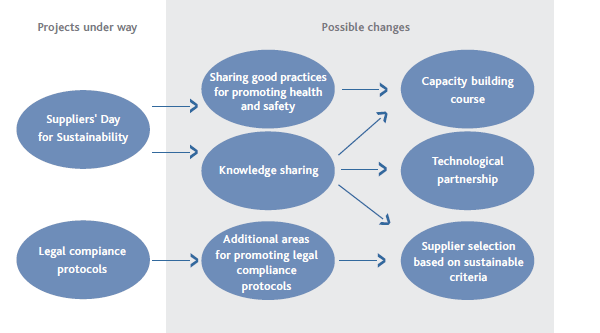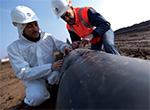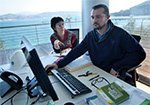
The following pages therefore outline key projects already in existence at the Company capable of generating shared value, along with an attempt to begin describing future projects. These include some initiatives now in an embryonic phase, others that are to undergo feasibility studies and then possible selection, and still others already incipient in the activities currently carried out by the Company and which will therefore be systematised and evaluated, with a view to maximising their potential capacity for generating shared value.
RELATIONS WITH SUPPLIERS
The supplier management process is intended to satisfy the procurement needs expressed by Snam’s corporate units, ensuring the quality of the suppliers involved and compliance with service level agreements, with the objective of maximising value in terms of products and services rendered to customers and minimising overall procurement costs. This process is therefore capable of generating value for Snam’s suppliers and partners, guaranteeing the Company greater reliability, adaptability and competitiveness, at the same time generating healthy entrepreneurial development countrywide. Thus, suppliers become more like business partners.
In 2011, a two-day workshop dedicated to suppliers was held, titled Suppliers’ Day for Sustainability, which dealt specifically with the subject of sustainability. This initiative awakened great interest and met suppliers’ needs in that regard, satisfying a relevant request sure to get the attention of the partners involved. The meeting with suppliers was an opportunity to express the Company’s commitment to sustainable development, to describe its importance for achieving business objectives and, above all, to share the values that support the Company’s operations. Security, transparency, attention to the community, respect for local areas and strengthening the licence to operate are indispensable values around which to seal a responsible and loyal relationship with suppliers, with the awareness that the success of Snam depends partly upon their contribution. The Suppliers’ Day for Sustainability was an initial gathering to build on increasingly aware collaboration between the Company and its suppliers. On that occasion, among other topics, the issue of corruption risk associated with suppliers’ activities was discussed in depth.
RELATIONS WITH SUPPLIERS - A SUMMARY CHART


Snam, in collaboration with the Prefecture of Caltanissetta, has in fact signed a legal compliance protocol for the territory of Gela. This experiment, carried out with the involvement of public and private partners, requires ethical conduct in relations between different parties, which is more restrictive than the legal requirements, ensuring sound oversight of the issue of lawfulness, to prevent the risk of corruption and promote the fight against organised crime, in support of fair, ethical and meritocratic local entrepreneurial development.
In addition, as another area where the Company is already developing shared value now, we must note its continual commitment to the creation of a broad culture for the promotion of worker safety and health, a culture that inevitably indirectly affects suppliers most exposed to risks in that area.
Based on shared value experiences that emerged during internal reconnaissance, which can be developed along some basic guidelines, Snam has thus launched a number of projects. The first provides for extending activities already under way.
The Company is evaluating actions aimed at disseminating the adoption of legal compliance protocols countrywide, in collaboration with institutions, in order to disseminate a new culture in more at-risk areas to affirm the universal principles of lawfulness, for the benefit of the local sector, making suppliers themselves aware of the importance of adhering to voluntary agreements in that sense. Contributing to the development of a strong regulatory framework of reference is a fundamental condition for developing entrepreneurship in support of Snam’s business. This also involves making efforts in the area of workplace safety. In 2010, Snam launched the “Objective Safety” project, an important corporate initiative spanning three years that aims to act on the culture of the workforce to improve their attitudes, behaviour and personal responsibility with respect to workplace health and safety, because it believes that excellence in performance comes from going beyond regulations in the sense of doing better.

The possibility is being studied of including suppliers among the parties involved in “Objective Safety”, the ultimate objective of which is to further reduce the number of accidents through an integrated approach with the involvement of all personnel, putting a common focus on and making the most of the positive experiences acquired by all of the companies involved in the business.
Progressively, it will be possible therefore to extend the abovementioned project with time spent specifically on suppliers, including subcontractors. The activities aimed at achieving the goal of reducing accidents generate shared value to the extent that they succeed in bringing a culture of excellence outside of the Company, in this case also for purposes of reducing social costs.
Making corporate know-how available with a network approach using a knowledge sharing system to support suppliers on the path toward continual improvement is one of the keys that may increase the Company’s competitiveness. A systematic and structured exchange of information (web-based or using other two-way models) represents an opportunity for the real-time transfer of information to improve administrative communication and to offer training and information in a process of assistance for continual improvement, aiding subjects of corporate interest. Using this system, the emphasis could be placed on the two areas discussed above, which Snam considers to be indispensable prerequisites for the development of healthy entrepreneurship: strengthening legal compliance, from the fight against organised crime up to furthering workplace safety.
In its day-to-day operations, Snam is already offering on-going assistance to suppliers to make them partners of value. The second shared value development directive goes precisely toward creating a partnership of excellence.
During the process of identifying activities with shared value, Snam is planning supervised training for smaller, unstructured family-run suppliers (which represent a large percentage of the group’s list of suppliers) via a capacity building course, aimed at growth, internationalisation, and accreditation with additional customers, including by implementing temporary consortia, in a framework of social and environmental responsibility. Over time, Snam intends in fact to strengthen a supplier selection process based on sustainability criteria, extending current requirements in the qualification process to all key sustainable development issues. This approach will generate a further natural selection among suppliers and a consequent impact on the sector. Strengthening supplier competitiveness means strengthening Snam’s competitiveness.
An additional initiative starts out from the assumption that today Snam is among the greatest “technology drivers” in Italy. The group is undoubtedly an early adopter of technologies, and requires specialised know-how from its partners. This has given rise to the idea of creating a working group guided by Snam that would involve the most innovative suppliers and possibly other outside players, such as research centres and universities, in developing technological skills and synergies between players. Snam boasts a large capacity to stimulate demand and allows indirectly for the growth of high-value local entrepreneurship, because it needs unique, high-tech solutions. It thus becomes more relevant to start up a technological partnership with suppliers, which is naturally compatible with regulatory provisions for the sector, in cooperation with the best institutions in this field, starting with specialised centres.
If we interpret the lines of action set out according to the Four Capital Model, it is clear that a large part of the activities identified are capable of increasing local economic capital primarily, with inevitable positive impacts on human capital and social capital, while respecting and making the most of natural capital.



